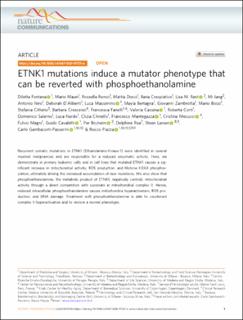| dc.contributor.author | Fontana, Diletta | |
| dc.contributor.author | Mauri, Mario | |
| dc.contributor.author | Renso, Rossella | |
| dc.contributor.author | Docci, Mattia | |
| dc.contributor.author | Crespiatico, Ilaria | |
| dc.contributor.author | Røst, Lisa Marie | |
| dc.contributor.author | Jang, Mi | |
| dc.contributor.author | Niro, Antonio | |
| dc.contributor.author | D’Aliberti, Deborah | |
| dc.contributor.author | Massimino, Luca | |
| dc.contributor.author | Bertagna, Mayla | |
| dc.contributor.author | Zambrotta, Giovanni | |
| dc.contributor.author | Bossi, Mario | |
| dc.contributor.author | Citterio, Stefania | |
| dc.contributor.author | Crescenzi, Barbara | |
| dc.contributor.author | Fanelli, Francesca | |
| dc.contributor.author | Cassina, Valeria | |
| dc.contributor.author | Corti, Roberta | |
| dc.contributor.author | Salerno, Domenico | |
| dc.contributor.author | Nardo, Luca | |
| dc.contributor.author | Chinello, Clizia | |
| dc.contributor.author | Mantegazza, Francesco | |
| dc.contributor.author | Mecucci, Cristina | |
| dc.contributor.author | Magni, Fulvio | |
| dc.contributor.author | Cavaletti, Guido | |
| dc.contributor.author | Bruheim, Per | |
| dc.contributor.author | Larsen, Steen | |
| dc.contributor.author | Rea, Delphine | |
| dc.contributor.author | Gambacorti-Passerini, Carlo | |
| dc.contributor.author | Piazza, Rocco | |
| dc.date.accessioned | 2020-11-24T08:35:12Z | |
| dc.date.available | 2020-11-24T08:35:12Z | |
| dc.date.created | 2020-11-23T14:14:41Z | |
| dc.date.issued | 2020 | |
| dc.identifier.citation | Nature Communications. 2020, 11, . | en_US |
| dc.identifier.issn | 2041-1723 | |
| dc.identifier.uri | https://hdl.handle.net/11250/2689217 | |
| dc.description.abstract | Recurrent somatic mutations in ETNK1 (Ethanolamine-Kinase-1) were identified in several myeloid malignancies and are responsible for a reduced enzymatic activity. Here, we demonstrate in primary leukemic cells and in cell lines that mutated ETNK1 causes a significant increase in mitochondrial activity, ROS production, and Histone H2AX phosphorylation, ultimately driving the increased accumulation of new mutations. We also show that phosphoethanolamine, the metabolic product of ETNK1, negatively controls mitochondrial activity through a direct competition with succinate at mitochondrial complex II. Hence, reduced intracellular phosphoethanolamine causes mitochondria hyperactivation, ROS production, and DNA damage. Treatment with phosphoethanolamine is able to counteract complex II hyperactivation and to restore a normal phenotype. | en_US |
| dc.language.iso | eng | en_US |
| dc.publisher | Springer Nature | en_US |
| dc.rights | Navngivelse 4.0 Internasjonal | * |
| dc.rights.uri | http://creativecommons.org/licenses/by/4.0/deed.no | * |
| dc.title | ETNK1 mutations induce a mutator phenotype that can be reverted with phosphoethanolamine | en_US |
| dc.type | Peer reviewed | en_US |
| dc.type | Journal article | en_US |
| dc.description.version | publishedVersion | en_US |
| dc.source.volume | 11 | en_US |
| dc.source.journal | Nature Communications | en_US |
| dc.identifier.doi | 10.1038/s41467-020-19721-w | |
| dc.identifier.cristin | 1851102 | |
| dc.description.localcode | Open Access This article is licensed under a Creative Commons Attribution 4.0 International License, which permits use, sharing, adaptation, distribution and reproduction in any medium or format, as long as you give appropriate credit to the original author(s) and the source, provide a link to the Creative Commons license, and indicate if changes were made. The images or other third party material in this article are included in the article’s Creative Commons license, unless indicated otherwise in a credit line to the material. If material is not included in the article’s Creative Commons license and your intended use is not permitted by statutory regulation or exceeds the permitted use, you will need to obtain permission directly from the copyright holder. To view a copy of this license, visit http://creativecommons.org/licenses/by/4.0/. | en_US |
| dc.source.articlenumber | 5938 | en_US |
| cristin.ispublished | true | |
| cristin.fulltext | original | |
| cristin.qualitycode | 2 | |

